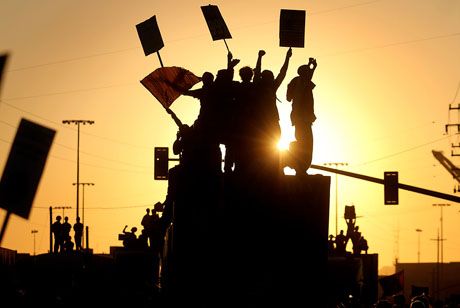Columns
You are here
Ontario workers fight back against Austerity

January 3, 2012
We are heading into a time of labour strife in Ontario. The provincial Liberals have sounded a warning with the Drummond Commission about cutbacks to come.
In Toronto, Mayor Rob Ford has declared war on the public sector unions. CUPE inside workers, outside workers and library workers are all facing negotiations, and the word from City Hall is that they have to pay the price for the economic crisis.
The city is putting forward concession-heavy proposals and is talking tough. Labour and the community have to respond to defend the jobs and services that are at stake.
The Ontario Federation of Labour (OFL) has just gone through its bi-annual convention and the delegates strongly endorsed the Unity Team headed up by president Sid Ryan.
The last two years have been marked by internal bickering and power struggles. A few unions cut their dues to the federation trying to cause a crisis, resulting in the lay off of staff and a questioning by employers of the capacity of labour to fight back against the austerity agenda.
Some leaders seemed more interested in personal power and advancement than the needs of working people and the poor. We believe that it is the rank-and-file that must mobilize in their workplaces to counter the boss’ agenda, but at the same time we do not stay neutral when there is a fight between the left and the right in the labour movement.
Sid Ryan and the Unity Team openly called for a militant fightback against the austerity agenda.
For the first time in years, in spite of dues being withheld and vicious internal disputes, the OFL put out the call to mobilize workers in support of the Vale Inco strikers in Sudbury.
Ryan called for unions to provide solidarity for the long running ECP strike in Brantford, which resulted in the shut down of the scabbed workplace for three days.
Ten thousand rallied in Hamilton due to the militancy of the 900 locked-out Steelworkers, and Ryan called for trade unionists from across the province to join them in the fight against US Steel.
When a labour leader pushes for this type of solidarity, it allows for activists to put pressure on their own leaders to mobilize in support. They will often run to catch up with the membership.
We cannot depend on the leadership to make the fight. In the end it is always the rank-and-file that will make the difference between winning and losing, but the labour movement in Ontario is in a better position with the overwhelming victory of the Unity Team at the OFL Convention. The members came out in record numbers for the convention to support a leadership, which was openly calling for a militant response from labour.
Common Front
A Common Front has been set up across the province linking labour and community with the hope that local and cross-province alliances can be made to mobilize against both provincial and municipal cutbacks.
In the city of Toronto, the next step is to continue the pressure on City Council. Two large mobilizations have taken place on September 26 and April 9, bringing thousands of people into the streets to protest the cuts. The Toronto and York Region Labour Council has called a rally for the evening of January 17, the first day of the council meetings.
We are seeing the fightbacks that are taking place in Egypt, India, Britain, Greece and many other countries. In the US, we saw the occupation and marches against the Republican-controlled state legislature in Wisconsin, and the huge mobilization of “We Are Ohio,” which was able to defeat the reactionary anti-labour legislation that the Tea Party legislature had passed.
The assaults are hard, but the working class is showing its resilience, winning some and losing some, but fighting back every step of the way.
Section:
Topics:
- Log in to post comments










